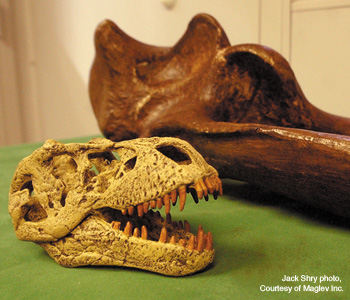Feature
Lasers in Paleontology
Paleontology has come a long way since early fossil-hunters roamed the Wild West at the end of the 19th century using sharp eyes, picks and shovels to excavate bones. Now, 21st century paleontologists are using lasers to record three-dimensional images of their discoveries, to analyze fossils, and to date rocks.
 A T. rex femur and miniature model of T. rex skull were used in test laser scans at the Carnegie Museum of Natural History in Pittsburgh.
A T. rex femur and miniature model of T. rex skull were used in test laser scans at the Carnegie Museum of Natural History in Pittsburgh.
Charles Sternberg’s The Life of a Fossil Hunter provides a fascinating picture of the early days of paleontology. He began searching for fossils in western Kansas in the 1870s, digging the up and shipping them to east-coast scientists. Western North America was rich in fossils, and in the years that followed, Sternberg and others uncovered a treasure trove that formed the foundation of American paleontology.
…Log in or become a member to view the full text of this article.
This article may be available for purchase via the search at Optica Publishing Group.
Optica Members get the full text of Optics & Photonics News, plus a variety of other member benefits.
